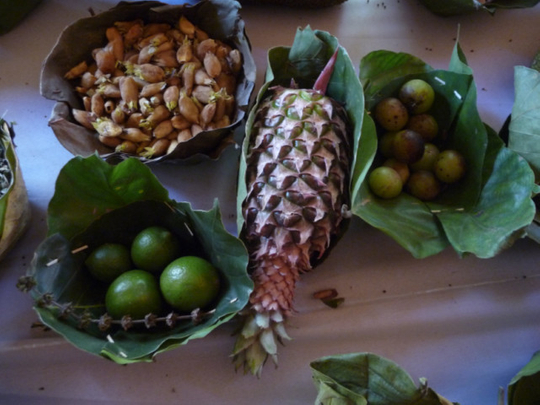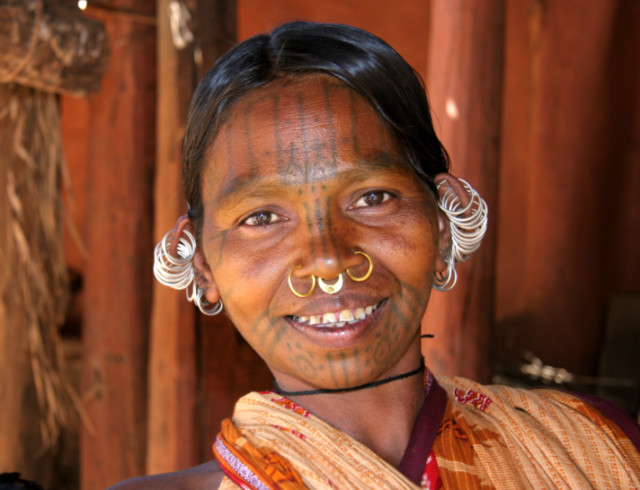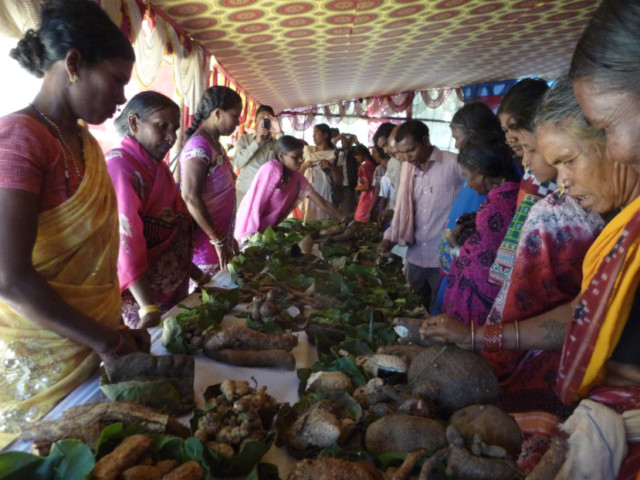
Earlier this year, I was invited to a two-day tribal foods festival at Bisamcuttack, in the eastern Indian state of Odisha. The significance of the venue, near the Niyamgiri hills, was not lost on those attending. The hills are home to the Dongria Kondhs, who worship Niyamgiri (“mountain of law”) as the seat of their god and protect the forests there. They were in the news in January after winning a case against Vedanta and putting paid to the British mining giant’s plans of extracting bauxite from the hills. The rare victory had gained the tribe worldwide attention, with the Western press dubbing it the “real-life Avatar” tribe after the Hollywood blockbuster.
The mood was upbeat as we were welcomed into the colourful tent with mandia jau, a traditional gruel made of ragi (finger millet) and rice. Women stood at the entrance with mahua flowers in their hands, which were offered to us to taste and smell.
More than 600 participants (most of them tribal women) from 300 tribal villages from various states such as Jharkhand, Chhattisgarh, Madhya Pradesh, Rajasthan, Bengal, Odisha and Maharashtra were present. The festival celebrated food traditions, ecology, biodiversity and self-sufficient communities of these tribal villages. More than 1,500 food items were on display; of these, as many as 972 were uncultivated and forest-foraged. The adivasis (aborigines) showcased around 400 recipes, offering a glimpse of their season-based food habits that have given them a long and healthy life for several thousand years.
On offer were patties made of ragi, jaggery and rice; a huge variety of forest-foraged greens; fish from forest streams and ponds; yams and tubers small and big — some like a leg of mutton (we were told that some yams need to be immersed in stream water for a day, otherwise they are toxic). A large portion of the dishes on display were based on millets — pancakes and cakes made from finger millet, foxtail millet, sorghum, pearl millet, kodo millet, barnyard millet with added jaggery — seeds and uncultivated fruits.
The highlight was the giralu — a flattish tuber from the forest that is used as a thirst quencher at times when water is scarce.
Guests were introduced to many uncultivated, multifunctional trees and plants. Like the big siali bean whose seeds are boiled or roasted. Its branches are used to make ropes and its leaves to make ecofriendly plates.
The mahua tree’s flowers are used to make liquor, jaggery and a kind of porridge. A kind of gravy is made from the fruit. The leaves are dried and cooked as a vegetable dish, or used as fodder. The seeds produce beneficial oil and the residue cake is used as fodder.
Kusum koli leaves are used for fodder, its fruits are eaten raw, the plant is used as firewood and oil is extracted from the seeds. The seed oil serves as a mosquito repellent and is also used to treat certain skin diseases.
On the second day, different tribal heads came together to talk about issues relating to nutrition security, biodiversity, and strategies to mitigate effects of climate change through preservation of their food systems.
“We wanted to highlight sustainable ways of growing food and their relationship with the adivasis’ ecology — land, plants, animals and forests,” said Debjeet Sarangi of Living Farms, an organisation that works on improving food and nutrition security. Living Farms organised the festival. With the help of tribals and volunteers, Living Farms documented the foods (“we recorded 276 varieties”) and recipes and recently brought out a report.
Sarangi says documentation was done to preserve the ingrained knowledge of the tribals, not only for the wellbeing of the future generations of the communities but for entire humanity — because the world is looking to indigenous peoples and their traditional food systems as a solution to hunger and malnutrition, biodiversity loss and climate change.
Back to the roots
The 2014 Global Hunger Index report (designed by the International Food Policy Research Institute to measure and track global hunger) recommends returning to traditional diets, comprising locally available, biodiverse food, to overcome growing undernutrition. The report points to a phenomenon called “hidden hunger”, faced increasingly by countries due to loss of diversity in diets, and dependence on monocrops such as wheat, maize, rice. This leads to diseases, malnutrition, undernutrition and micronutrient deficiencies.
“Many traditional and non-processed foods consumed by rural communities such as roots and tubers, millets, sorghum, beans, oil seeds, wild edible greens, fruits, etc are nutrient-dense and offer rich micronutrients widely lacking in processed foods,” Sarangi says.
It is no surprise then that indigenous foods are the rage today with even popular food shows like “Masterchef Australia” throwing around words such as “saltbush” and “samphire” — native foods of Australia. Several countries have begun annual festivals and events showcasing indigenous foods; celebrity chefs, restaurants and nutritionists are advocating their use to stay healthy; ancient grains such as amaranth, quinoa and ragi, used for centuries in countries such as Brazil and India, are being talked about in the West; restaurants are going native, serving up foods like “bush tucker” cuisine. And events and talks are being organised in cities to teach people the link between food, culture, health and the environment.
For example, the annual Mei-Ramew Festival in northeast India, held in association with Italy’s Slow Food International, had 23 communities showcasing 200 species of edible and medicinal plants. There are several others such as the Bhoomi Utsav and the Beej Bachao (Save The Seeds) festival. Coming up in December is a national conference and exhibition on Uncultivated Forest Foods in New Delhi where forest-dwelling communities from more than ten states will participate and exhibit local foods.
Simultaneously, there is a rush to document indigenous foods and food systems that are disappearing — belonging to the nomadic hunter-gatherers such as the Aché in eastern Paraguay, the Masai pastoralists in northern Kenya, the Sami of Scandinavia and the millet-farming Kondh in eastern India. It is now widely recognised that indigenous peoples are the custodians of much of the world’s biodiversity providing nutrition. Studies have shown that their food systems are diverse, resilient and have minimal impact on the environment. The most important trait these groups share is a knowledge of how to eat nutritiously without damaging the ecosystem. “Indigenous peoples’ food systems contain treasures of knowledge from long-evolved cultures and patterns of living in local ecosystems,” says an FAO-supported 2009 study on indigenous food systems, nutrition and health.
Modern food systems leads to disconnection
Today’s industrial mode of food and agriculture has contributed greatly to people being disconnected from the food they eat and habitats that produce food. “Much of our environmental and ecological destruction is a consequence of our society’s detachment from food systems,” says Bharat Mansatta, organic farmer and activist. Mansatta is co-owner of Van Vadi, a forest farm collective near Mumbai, and organises the annual forest festival, Vanotsav. “If you are closely linked to their food system, you cannot think of harming it.”
“The jungle is like our mother. She takes care of us, nurtures us,” says Kondh tribal Jagannath Majhi. “People think of selling forests as if it is a commodity. We can’t think of our mother as a commodity. Forests are living things. You can’t get the rich diversity that a forest gives from a shop.”
Kondhs are worried about the influence of agricultural corporations and government food schemes. “Traditionally, we do mixed farming [‘mistrit kheti’] with about 12 crops grown together,” Hepruka Kurunji says. “But many people in our area have been lured into growing hybrid seeds or cash crops like cotton with promises of big money. But they are not earning much, and are instead getting indebted to moneylenders.”
Minati Tuika points out government schemes like the food security programme which promise families rice for prices as low as Rs2 (Dh12). “They force us to abandon our own food security system so painstakingly built by our forefathers. All these schemes weaken our link with traditional agriculture and the jungle.” They would rather have their existing food systems strengthened.
Declining forest cover
The availability of wild foods is decreasing as forest land disappears due to deforestation, often to make way for large-scale agricultural production. This also affects the collective knowledge of the land, sky and sea that the tribal people have, which made them excellent interpreters of changes in the environment. This collectively held knowledge offers valuable insights critical for evaluating climate-change scenarios. “We could figure out how late the rains would be just by the nature of dewdrops and mist. Now there is no mist or dew in the forest. How will our children do it?” asks Kondh adivasi Sona Kutruka.
The Kondhs lament the loss of knowledge as their younger generation turns to urban cultures for inspiration. At the conference, tribal mothers talked about their inability to stop youngsters from buying monocrop vegetables such as hybrid tomatoes and potatoes: “Our children ask why we should eat this food; we prefer the market foods.”
The outside world encroaches on them in many other ways. At the Odisha tribal festival, the interesting fiery red tinge of a dish turned out to be ready-made chicken masala — “it tastes good, so we put it in the powder”.
Experts note that genetic diversity is nature’s backup against disaster. If a disease affects one variety of a crop, other varieties may have the genetic strength to resist it. It is the loss of genetic diversity within species that weakens our resilience to pests, diseases and climate change. “The loss of biodiversity will have a major impact on the ability of humankind to feed itself in the future, all 9 billion of us by 2050, with the poorest in the world most affected,” warns the FAO.
The hope then lies with people like the Kondhs who have drawn up a plan to bring back vanishing foods and protect their biodiversity: starting seed banks in all villages, collecting and storing seeds, starting seed nurseries. “Our community will decide what seeds to plant — not outsiders who tell us to plant eucalyptus and teak.” They will be back next year with another food festival and a gathering of tribes to discuss the way ahead. They will involve children in local schools with talks on indigenous foods.
“All things on this planet are interconnected, so is our food supply — we are eating from one giant plate,” Mansatta says. “As the Odisha festival and countless other such events around the globe indicate, we need to now share the burden of supporting healthy food systems.”
Anuradha Sengupta is a writer based in Mumbai.














